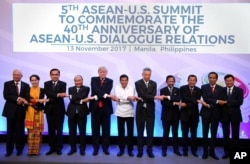China calmed Asia's biggest maritime sovereignty dispute in 2017 by offering aid, investment and the pledge of negotiations with weaker Southeast Asian countries as Beijing's chief nemesis, the United States, kept quiet.
These shifts in the South China Sea sovereignty dispute involving six governments allow Beijing to minimize public criticism of its claim to about 90 percent of the waters stretching from its southern coast to the island of Borneo. That calm in turn lowers risk of conflict.
“The U.S. State Department, the Pentagon, when they look at Asia they are inclined to think that it’s a peaceful place, because we’ve found a way to communicate despite disagreements and to accept disagreements as they are,” said Alan Chong, associate professor at the S. Rajaratnam School of International Studies in Singapore.
Brunei, Malaysia, the Philippines, Taiwan and Vietnam assert sovereignty over all or parts of the 3.5 million-square-kilometer sea. Claimants prize the tropical body of water around some 500 tiny islands for its fisheries, marine shipping lanes and undersea fossil fuel reserves.
China cites historical fishing records to back its claims. Since 2010 the technologically superior country has angered its neighbors by using landfill to build up islets for military installations. In 2016, a world arbitration court ruled, at the Philippines’ request, against the legal basis for Chinese maritime claims.
Aid and investment for other maritime claimants
China rejected the arbitration but spent much of 2017 shoring up relations with individual Southeast Asian claimants.
Backed in part by its $11.2 trillion-plus economy and $900 billion “One Belt, One Road” initiative to connect much of Asia for trade growth, the country offered investment and other aid to rival Southeast Asian maritime claimants.
China agreed to sell naval ships to Malaysia, which already counts China as its top trade and investment source. After befriending the Philippines last year, the Chinese government pledged $24 billion in aid and investment for Manila. This year the pair discussed funding two Philippine railway projects for a combined $8.3 billion.
In Vietnam, more than 3.59 million Chinese tourists visited from January through November for a 45 percent increase over the same period of 2016. China was Vietnam’s top source of arrivals that are expected to total 13 million for full 2017.
Peeps but no squawks
In July, China apparently pressured Vietnam to quit an oil and gas exploration project in their disputed waters. Also that month, the Philippines went on alert over reports of Chinese activity near its nine Spratly Island holdings.
But overall this year, the Southeast Asian countries played down China’s control of the sea, including fortification of disputed islets and passage of ships through their maritime exclusive economic zones.
Negotiations with Southeast Asian states
Last month China agreed to start talks in 2018 with the 10-member Association of Southeast Asian Nations (ASEAN) on a code to prevent accidents at sea. Four of those countries believe China is infringing on their maritime claims.
The code will spell out ways to prevent accidents in the sea and avoid the likes of deadly Sino-Vietnamese clashes in 1974 and 1988. China had stalled progress for six years on that code, which was born out of a declaration in 2002.
Code signatories are not expected to touch on issues of maritime sovereignty.
“I think at this point in time the whole idea is to ride on the momentum of goodwill,” said Collin Koh, maritime security research fellow at Nanyang Technological University in Singapore. “Once the negotiations for the code of conduct begin early next year, I still see China putting up this goodwill posture for ASEAN for now.”
Change of U.S. president
China regards the militarily stronger United States as its key concern at sea as Washington backs freedom of navigation rather than China’s goal of outright control, analysts believe.
Since taking office in January, U.S. President Donald Trump has not clarified whether he will pursue a freedom-of-navigation policy. The U.S. navy still occasionally sends vessels, but experts say those moves fall short of a consistent policy that China’s Asian maritime rivals want.
“What China sees as the biggest threat to its security is the American military reconnaissance and the surveillance in the South China Sea,” said Yun Sun, East Asia Program senior associate at the Stimson Center think tank in the United States.
“The ability to fend off or push away the American military presence is more important to China than the territorial sovereignty or the territorial integrity,” she said.
Former U.S. president Barack Obama’s government irked China by shifting military attention to East Asia, including joint naval patrols with the Philippines and lifting a U.S. ban on selling lethal weapons to Vietnam.
Now Beijing’s official responses to U.S. operations in the sea have “settled into a comfortable groove” to assure the Chinese public it is fending off U.S. ships, wrote Andrew Chubb, a postdoctoral fellow at Princeton-Harvard China in the World Program.
Slow consecration of control
China used the calm of 2017 to bulk up its claims without massive projects that would fan outrage, scholars say.
One means was technology. In 2017 Chinese researchers christened a bathyscaphe deep ocean probe and a drone equipped for maritime transport and surveillance.
State-run Chinese media confirmed this month China had sent jet fighters to Woody Island in the Paracel archipelago off its South Coast.
China often starts deployments or construction at sea “sneakily,” then brings in more after “paving the ground psychologically,” Sun said.
U.S. maneuvers sometimes spark a tightening of China’s positions in the name of “defensive purposes,” Koh said.









